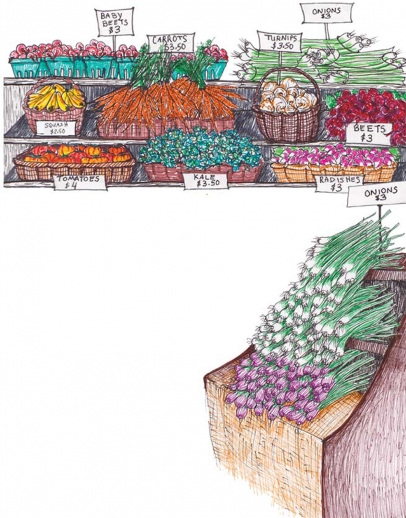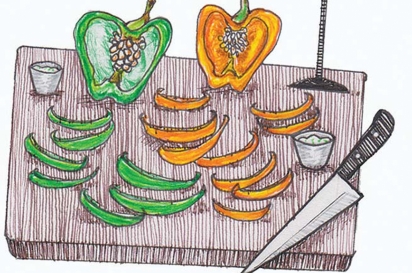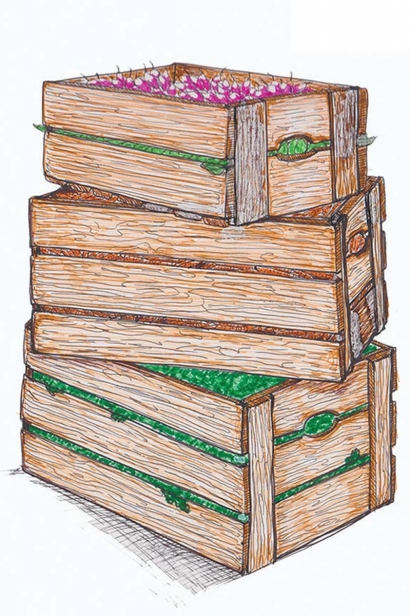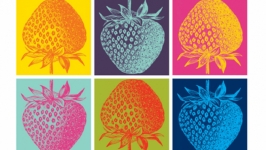The Principles of Good Farmers' Market Design
Pile it High
Though delicious local produce on a summer’s day might seem like it could sell itself, a lot goes on behind the scenes to create a successful farmers’ market. To learn the tricks of trade, I conversed with a number of vendors at the summit farmers market, one of the state’s most successful and bustling. here are some of the secrets these food magicians were willing to reveal.
ABUNDANCE
“Pile it high, and it will fly. Keep it low, it won’t go,” rhymes Lisa Ossiboff, market manager at Phillips Farms in Milford. “Creating a look of abundance always draws people in.”
It’s true. Produce piled high and tight on a small table looks more appealing than the same amount of produce on a larger, empty- looking table.
Ossiboff says creating a soft, natural look also complements the intimate feel of a local market. This means her bins are rustic and made of natural materials like wood.
Lastly, her signage is simple and offers short, useful tips. “Informing customers which apple is better suited for sauce than salad, how to store different types of produce or what items continue to ripen after they’re picked goes a long way,” she says. “Knowing your food and being excited about enjoying it is contagious.”
BRAND CONSISTENCY
At a market as busy as Summit, smart branding captures the attention of market- goers, while a well-organized table can help make the shopping experience as effortless as possible.
“Our logo is on our truck, on our banner, and on our shirts,” says Bea Tassot of Tassot Apiaries in Milford. “Our brand is always visible.” That logo comes with a catchy tagline that reminds customers that the apiary “turns flowers into gold.” In addition to an easy-to-identify stand with a prominent logo, Tassot also stresses the value of a consistent setup. At the numerous markets Tassot Apiaries attends, the setup is always exactly the same: Tables are arranged in a large “U” shape and the products are always situated in the same place. “Not only does this make it easy for us when it comes to setting up, it helps the customer know exactly where to find the product they are looking for.”
FRESHNESS AND HONESTY
“When butterflies or bees seek food, it’s the most beautiful, colorful flower that draws them in. Not only is there a natural attraction, there is literally an electrical charge,” says Mike Rassweiler, owner of North Slope Farm in West Amwell, referring to the fact that bees can actually sense the electric field that surrounds a flower. “We view our customers the same way, and we present our best produce to draw them to our table.”
North Slope takes pride in bringing the freshest, just-picked produce to market, and the farmers take extra care by harvesting before the day gets warm and by placing items into cold storage immediately. Though North Slope is an organic farm and grows all its own organic produce, they do carry a handful of items that are grown conventionally (though locally) by other farmers, like fruit and mushrooms.
Both organic and conventional items are clearly labeled, and prices are easy to find so customers can shop with all the information they need. “People want to be informed,” Rassweiler says. “When there are items at our stand that were not grown on our farm, we make sure they know exactly what they are, how they are grown, and what farm they were grown on. Since many of our customers have been coming to our stand for years, they know these items are ones that I’ve personally chosen to bring them because they are special and fill a need.
We seek to present an honest representation of our farm to create a connection with people.”
KNOWLEDGEABLE STAFF
Faye Johnson, cave manager at Valley Shepherd Creamery in Long Valley, works hard to educate all staff in the finer points of cheese-mongering. Come market day, this education helps build customers’ confidence that the person behind the table actually knows what they’re talking about.
“People learn to ask, ‘What’s good in the cave?’ or ‘How are the animals doing?’” says Johnson. “It’s a fantastic feeling to foster these relationships and help folks form a better connection to their food.”
Free samples never hurt either, and patrons are encouraged to try before they buy. When a customer does decide to bring home the cheese, it’s always cut to order.
Nothing is pre-cut or pre-packaged, so customers can purchase exactly the amount they need.
PREPARING FOR THE RUSH
“When you’re getting up at 6am, you want to run on autopilot,” says Matt Conver of Cherry Grove Organic Farm in Princeton. That’s why bags, cashbox, tables, scales and display baskets are all packed the night before and checked off on a checklist.
Being ready for the inevitable rush during the market is just as important. As items sell, Cover and his work crew immediately restock from bins that are easy to access under the tables. Additional produce is stored on their truck, ready to resupply the tables and bins as needed.
Conver and his staff also wear change belts so customers don’t have to wait in line for the register when the stand is busy. Ample staffing is important as well. During the busiest time of the season, he staffs the stand with as many as seven people.
“You have to anticipate the rush,” Conver says. “The stand looks so pretty in the morning, and you want it to stay looking that way all day. It’s hard to keep up—but you have to.”
Brad Finkel of Hoboken Farms sums up the energy inherent in thoughtful market design. “Every Sunday morning, we try to put on an entertaining show and have a quick but meaningful conversation with every customer. Abbondanza (abundance) mixed with fun, clean, educational graphics is the retail display combination that has best served Hoboken Farms. Pile the bread high, build an eye catching display, make sure the banners and t-shirts all tell the same graphic story, smile, smile, smile, smile.”
Editor’s Note: The Summit Farmers Market takes place every Sunday, 8am-1pm, at the corner of Maple Street and DeForest Avenue. Through November 20th.
BRINGING GOOD DESIGN HOME
Here are some ways market vendors stay mindful of good design in their own homes and kitchens
“To increase the allure of a cheese plate, I leave a little bit of the rind on the ends of pieces of hard cheese. It’s more aesthetically pleasing and gives people something to hold onto.” —Faye Johnson, Valley Shepherd Creamery
“I have small children at home, so it’s important to make vegetables look appealing so they will get eaten. We arrange vegetables so there is a variety of color, creating a feast for the senses.” —Matt Conver, Cherry Grove Organic Farm
“At market, we set up the stand as if people are coming to a banquet. When I put dinner on the table, I do the same. The display and variety helps entice my 8-year-old son to pick up his vegetables and put them in his mouth.” —Mike Rassweiler, North Slope Farm
“When basil is in season, it grows big and tall. I treat it like a bouquet of flowers and place the stems in a large glass of water and keep it on my kitchen table. It’s a great way to store a large bunch of basil while creating a nice natural centerpiece. I can pinch off leaves throughout the week and use them to cook as needed.” —Lisa Ossiboff, Phillips Farms
“We bring the natural look and feel of our farm stand into our home. Beeswax candles can always be found on the kitchen table, and our honey soaps are kept next to the sink for all to enjoy.” —Bea Tassot, Tassot Apiaries








